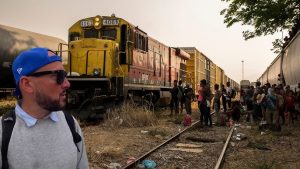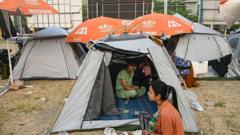As thousands of migrants embark on dangerous journeys atop freight trains like "The Beast," they confront life-threatening challenges and the harsh realities of survival. Amid increasing insecurity and political shifts, the migration crisis continues to elicit concern and demands for humane responses.
Perils of Migration: The Dangers of “The Beast” Train Journey to the U.S.

Perils of Migration: The Dangers of “The Beast” Train Journey to the U.S.
Migrants risking their lives on freight trains highlight the complexities of the global migration crisis amidst shifting political landscapes.
Article Text:
Migrants seeking a better life in the United States often endure harrowing journeys through Mexico, with one of the most hazardous methods being transit via a freight train dubbed “The Beast” or “La Bestia.” This cargo train, not designed for human transportation, has gained notoriety for its lethal risks. Each year, thousands from Central America and Venezuela climb onto moving railcars, fully aware that a single misstep could lead to devastating consequences.
The experience aboard “The Beast” is fraught with danger. Migrants cling precariously to the tops of the railcars in cramped conditions, with constant movement compounding the risk, especially as they jostle for space. A security consultant recently recounted a chilling incident, shared in the New York Post, that highlighted the vicious reality of such voyages, noting how overcrowding can provoke violent pushes resulting in horrific accidents. “I show a video in my talks of one person being sliced in half after he falls off a train and onto the wheels,” the consultant stated, underscoring the brutal nature of these journeys. Reports indicate an alarming risk, with around 500,000 individuals attempting travel on these “death trains” yearly, which illustrates the depth of desperation propelling these migrations.
In anticipation of stricter immigration policies under President-elect Donald Trump, an increase in migrants has been noted. Residents near train stations, including Durango resident Claudia Rios, reported heightened activity, with groups of over 200 attempting to board the trains. Rios observed changes in migrant behavior, stating, “Lately they come very aggressive, like all the good, all the kind migrants have crossed.” She also noted that children and individuals in wheelchairs were trying to board, revealing the extreme risks they are willing to take.
In Texas, Governor Greg Abbott has initiated a new strategy to confront the migration issue. Following previous measures such as razor wire barriers and transporting migrants to sanctuary cities, the latest effort features a stark advertising campaign designed to dissuade potential travelers. Billboards bearing messages like “How much did you pay to have your daughter raped?” and “Coyotes lie. Don’t put your family at risk,” have been installed in Mexico and Central America. The messages, presented in four languages, serve to warn migrants against the perilous journey. At a press conference in Eagle Pass, Abbott explained, “The message is, ‘Do not risk a dangerous trip just to be arrested and deported.’”
Simultaneously, human rights organizations, including WOLA, have spotlighted the rising violence towards migrants. They assert that kidnappings and extortions are on the rise, marking this period as one of the most violent phases in recent history. WOLA also claims that numerous Mexican authorities either tolerate or are complicit in these acts, compounding the threats faced by migrants.
From the treacherous travels atop “The Beast” to the alarming billboard warnings, the migrant crisis embodies the stark realities of desperation and survival. As policies adapt and the human toll escalates, these narratives pose critical inquiries into the challenges and repercussions of migration in our contemporary landscape.
Migrants seeking a better life in the United States often endure harrowing journeys through Mexico, with one of the most hazardous methods being transit via a freight train dubbed “The Beast” or “La Bestia.” This cargo train, not designed for human transportation, has gained notoriety for its lethal risks. Each year, thousands from Central America and Venezuela climb onto moving railcars, fully aware that a single misstep could lead to devastating consequences.
The experience aboard “The Beast” is fraught with danger. Migrants cling precariously to the tops of the railcars in cramped conditions, with constant movement compounding the risk, especially as they jostle for space. A security consultant recently recounted a chilling incident, shared in the New York Post, that highlighted the vicious reality of such voyages, noting how overcrowding can provoke violent pushes resulting in horrific accidents. “I show a video in my talks of one person being sliced in half after he falls off a train and onto the wheels,” the consultant stated, underscoring the brutal nature of these journeys. Reports indicate an alarming risk, with around 500,000 individuals attempting travel on these “death trains” yearly, which illustrates the depth of desperation propelling these migrations.
In anticipation of stricter immigration policies under President-elect Donald Trump, an increase in migrants has been noted. Residents near train stations, including Durango resident Claudia Rios, reported heightened activity, with groups of over 200 attempting to board the trains. Rios observed changes in migrant behavior, stating, “Lately they come very aggressive, like all the good, all the kind migrants have crossed.” She also noted that children and individuals in wheelchairs were trying to board, revealing the extreme risks they are willing to take.
In Texas, Governor Greg Abbott has initiated a new strategy to confront the migration issue. Following previous measures such as razor wire barriers and transporting migrants to sanctuary cities, the latest effort features a stark advertising campaign designed to dissuade potential travelers. Billboards bearing messages like “How much did you pay to have your daughter raped?” and “Coyotes lie. Don’t put your family at risk,” have been installed in Mexico and Central America. The messages, presented in four languages, serve to warn migrants against the perilous journey. At a press conference in Eagle Pass, Abbott explained, “The message is, ‘Do not risk a dangerous trip just to be arrested and deported.’”
Simultaneously, human rights organizations, including WOLA, have spotlighted the rising violence towards migrants. They assert that kidnappings and extortions are on the rise, marking this period as one of the most violent phases in recent history. WOLA also claims that numerous Mexican authorities either tolerate or are complicit in these acts, compounding the threats faced by migrants.
From the treacherous travels atop “The Beast” to the alarming billboard warnings, the migrant crisis embodies the stark realities of desperation and survival. As policies adapt and the human toll escalates, these narratives pose critical inquiries into the challenges and repercussions of migration in our contemporary landscape.





















